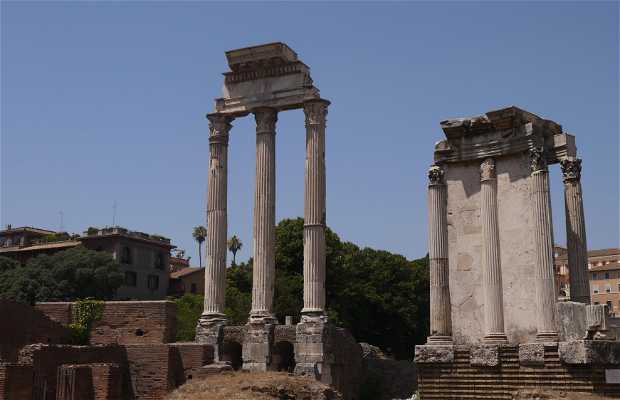Chris Pearrow
Temple to the gemini twins
Templo a los gemelos de Géminis
El Templo de Cástor y Pólux es uno de los monumentos más emblemáticos y evocadores del Foro Romano. Aunque los tres columnas restantes son unos de los elementos más inmediatamente reconocibles del Foro Romano, son solamente una fracción del templo original que fue destruido y reconstruido varias veces durante los siglos.
El templo original fue construido en el siglo V AC para el culto de Cástor y Pólux, también conocido como los gemelos de Géminis, figuras originalmente de la mitología griega antigua. El templo fue destruido más tarde en un incendio devastador y reconstruido por Tiberio en el año 6 dC, los restos de los cuales vemos hoy. Durante su vida, fue utilizado como templo, un lugar de reunión secreto para el Senado, un almacén y una oficina del gobierno. En los siglos oscuros que siguieron al colapso de Roma, el templo fue desmantelado con sus partes recicladas en otros edificios alrededor de la ciudad, dejando solamente las tres columnas fantasmales que vemos hoy.
Es uno de esos monumentos típicos que es agradable de ver en la vida real, pero cuyo verdadero interés radica más en la historia detrás de ella que en las ruinas que se encuentran hoy en día. Aun así, merece una visita sin duda.
The Temple of Castor and Pollux is one of the most emblematic and evocative monuments of the Roman Forum. Although the three remaining columns are some of the most immediately recognizable elements of the Roman Forum, they are only a fraction of the original temple that was destroyed and rebuilt several times over the centuries. The original temple was built in the 5th century BC for the cult of Castor and Pollux, also known as the Gemini twins, figures originally from ancient Greek mythology. The temple was later destroyed in a devastating fire and rebuilt by Tiberius in AD 6, the remains of which we see today. During his lifetime, he was used as a temple, a secret meeting place for the Senate, a warehouse and a government office. In the dark centuries following Rome"s collapse, the temple was dismantled with its recycled parts in other buildings around the city, leaving only the three ghostly columns we see today. It is one of those typical monuments that is pleasant to see in real life, but whose true interest lies more in the history behind it than in the ruins that are found today. Even so, it deserves a visit without a doubt.




